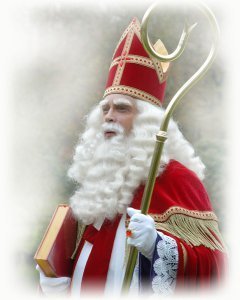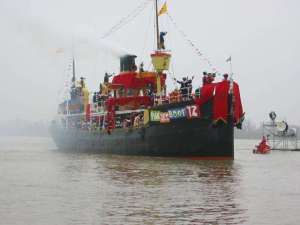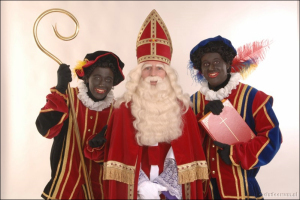Sinterklaas – A History
This is an old article that I wrote and had published in an Expat Magazine when I first moved to Holland. It earned me a whole 200 Euros and I was delighted.
Today is the day that Sinterklaas arrives in Holland, and the holiday period officially begins. In a later post I will talk about the Traditions of Sinterklaas and the way it is celebrated, but for now, please enjoy my article.
Sinterklaas – A History
Although it may sound like a foreign pronunciation of Santa Claus, Sinterklaas and the feast that celebrates his are different in many ways to the Santa Claus that we know in Britain.
Sinterklaas was a real man, whereas Santa in merely a fictional creation who came about hundreds of years ago after worshipping saints was banned by the same Church to which Sinterklaas dedicated his life. Sinterklaas (an amalgamation of his real name Saint Nicolas, or Sint Niklaas) is nonetheless the man on whom the myth of Santa was eventually based.
Young Priest
Nicolas was born into a wealthy family in 271 AD in Myra (modern-day Turkey) and until his parents died during an epidemic, he lived the life of a rich man. It is only after this incident that he begins to become the person that we all know in some form today. Nicolas decided to dedicate his life to the Church and became the youngest ever recorded priest at the young age of 19. A generous man, he distributed his wealth amongst the poor.
Gold Coins
Perhaps the most famous episode of his generosity was when he came to the aid of a local nobleman, who had three daughters but not enough money to offer any dowry. Nicolas heard about this man's woe, visited his house in the middle of the night and placed a pouch filled with gold in the shoe of the eldest daughter. (It is thought that perhaps this act gave rise to the Dutch tradition of the children placing their shoe by the radiator the night before the Sinterklaas feast, to find chocolate gold coins inside when they wake up.) In the morning, this gift was discovered and the money served as ample dowry for the daughter to marry. Nicolas then made two further visits to the house, each time leaving a sum of gold. The gold was well-received and all three daughters were eventually married, and able to avoid living a life of shame. After the third visit, the nobleman caught Nicolas and demanded to know who his mystery benefactor was. Once Nicolas revealed his identity he made the nobleman swear an oath not to tell a living soul as long as Nicolas was alive.
Patron Saint
Tales of Nicolas' generosity soon spread, though whether by the nobleman or not it unclear. Soon everyone was praying to Nicolas for aid. Falsely imprisoned people prayed for help and saw the prison walls allegedly crumble around them. Crews on ships that were lost in storms prayed for help and witnessed how the seas calmed and the ship was guided to a safe harbour. While Nicolas' direct influence in this is doubtful, the people themselves believed in it.
Another tale regarding Nicolas says that he saved the lives of three boys who had been kidnapped by a farmer and his wife. The boys had been dissected and placed in various pickling barrels around the house. Nicolas came to the farmhouse and charged the couple with the murders and the boys apparently rose from the grave completely restored of life. It is because of these events that he became the patron saint of sailors and merchants, and more importantly to his legend, the patron saint of children.
Turbulent Life
Despite being celebrated now for his generosity, Nicolas endured a turbulent life within the Church, and was actually imprisoned and tortured along with many other devout Christians during the violent years under the reign of Emperor Diocletian. Nicolas in fact remained incarcerated until the Church was reinstated by Constantine.
Low Countries
The legend of Sint Nicolas was easily adopted in the Low Countries, Holland and Belgium, as both nations were heavily involved in sea travel and navigation. The Dutch alone were so taken by the legend of Nicolas that they built 23 individual churches dedicated to his memory. Amsterdam even declared Nicolas the patron saint of the city itself.
Throughout Holland, the feast of Sinterklaas is still celebrated, more so than Christmas. Yet it was not the Dutch that set the dates for the feast, it was Rome and the date was set to mark the date of Nicolas' death, December 6th.
Steam Boat
The figure of Sinterklaas arrives in Holland around November 20 on a large steam boat from Spain. The reason he lives in Spain throughout the year is not actually known, but this is what is inferred in the songs the sailors used to sing about him. Sinterklaas sits on the boat atop his white horse Amerigo and is surrounded by his helpers, called Zwarte Pieten. The origins of Zwarte Piet are also a mystery, but one possible conclusion is that they were slaves, possibly taken from the African countries that were under Dutch control.
Zwarte Piet
Zwarte Piet has dark skin, but is played by Caucasian people who have their skin cosmetically darkened. They have curly hair and wear a brightly coloured beret with a feather in it, as well as red lipstick and golden hoops in their ears. However, despite possibly being a slave, Zwarte Piet is a happy fellow, who sings and dances wherever he goes, and is often seen doling out sweets and small cookies to the children who turn out to see him and Sinterklaas – and unlike the elves who are the equivalent for Santa Claus, the scores of Zwarte Pieten are involved throughout the entire holiday, helping Sinterklaas hand out his gifts.
To this day, there are still protests in Holland about the supposed racist message that this festive time presents to the young and impressionable children who follow it so closely. Nonetheless, over the centuries, it has never proven to give the children the wrong idea about people of a different colour. How could it, when Zwarte Piet is such a happy-go-lucky and generous fellow?
Upholding a Belief
It takes some careful planning to uphold the belief that Sinterklaas visits all children in one single night. The smart children, still naive enough to believe in the holiday but fully aware of the limitations of time travel, are told that the real Sinterklaas only delivers gifts to the houses in the town where his ship moors and that the rest of the country is dealt with by helpers who dress like Sinterklaas and Zwarte Piet. This tends to be readily accepted by all but the most inquisitive children.
Not a Religious Holiday
Despite the time of year and the career path of the person it celebrates, the holiday is not actually a religious one, though Sinterklaas still appears in a red mantle and mitre, holding a large gold bishop's staff, cutting a rather different and statelier figure than his plump, jolly counterpart.
Poem
Another way that this holiday differs from the one celebrated in Britain is in the lack of commercialisation and self-centeredness. The gifts given (which are exchanged on December 5th) are very carefully chosen, with the emphasis being on the thought rather than the monetary value. A great deal of thought is also given to the wrapping of the gift; traditionally it also comes with a challenge, either a riddle or possibly a treasure hunt before it can be opened. This not only adds to the occasion but also means that the holiday can be celebrated and enjoyed by people of all ages. A common theme is to make a 'Surprise' which is an elaborate creation within which the gift is hidden.
Last year my Brother in Law made me a huge typewriter, and my wife made a giant SpongeBob. You can see other examples here (just click on the links to see the surprise)
Another important aspect is the accompanying poem; one filled with originality, composed by the giver of the gift, using any information that can be obtained about the recipient, making it a no-holds-barred biography of the person. Nothing is off-limits, the more embarrassing the better, whether it is from mother to daughter or employee to employer.
Personally, I find Sinterklaas to be a very different experience. The whole occasion seems to be more family-oriented than the traditional Christmas many people are used to, which only serves to make the whole season more enjoyable.
Magic
There are many places in the world that claim to house to bones of Saint Nicolas, including the Italian cities of Venice and Bari. However, their true final resting place is believed to be in his home town of Myra. The area itself has been thoroughly excavated, but the bones have long since turned to dust, meaning that their real location may never be revealed to the world.
Personally I feel that it is best that their location never be discovered, as whatever festive figurehead you choose to follow at this time of year, the real 'truth' is that the gifts really are brought down our chimneys or left in our shoes – and if we stop believing this truth and try to prove what really happened, then we are all simply empty and lost. The real magic of the season comes from our own imagination, and it is best kept that way.














